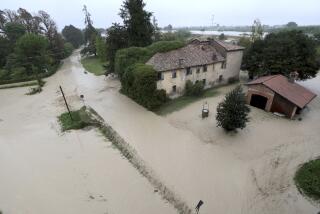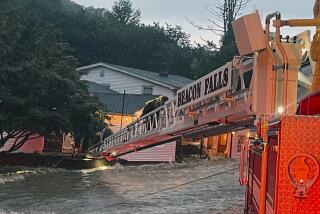Rivers in Pa. Head Higher
SCRANTON, Pa. — As the Susquehanna River rose Wednesday night, 200,000 people were ordered to leave their homes near Wilkes-Barre in anticipation of cresting waters that threatened to top the city’s levees this morning and pour into residential neighborhoods.
The evacuation came after another day of torrential rain in the Northeast that left at least 12 people dead. Houses were lifted from their foundations, bridges washed away and terrified residents awaited rescue on their rooftops.
As her family hurried to leave Wilkes-Barre at 7 p.m., an hour before the evacuation deadline, Anna Campos, 14, looked back at a street that was weirdly silent -- no children playing, no parents watching them, no pets, no pedestrians. She imagined her bedroom brown with floodwater.
“I’m scared of going home,” she said.
Wilkes-Barre has been engulfed before, when the remnants of Hurricane Agnes raised the river’s level to 40.9 feet. Water flooded into the Wyoming Valley, washing 2,000 caskets out of a cemetery. The governor and his wife had to be rescued from their residence in Harrisburg. The 1972 flood caused 50 deaths and is considered among Pennsylvania’s worst natural disasters.
Linda Ciechoski, 54, recalled that flood as she tried to gather her jewelry and photographs together. She gave a last look at her television, in the den of her single-story home.
“It’s just nerve wracking,” she said. “What’s really sad is to see the old people try to get their things together.”
Thousands of people also were ordered to leave their homes in New Jersey, New York and Maryland.
Flooding closed many roads in the Philadelphia area, including the Pennsylvania Turnpike.
“We lost just about everything -- the cars, the clothes, even the baby’s crib,” said James Adams, who evacuated his family’s home near Binghamton, N.Y., after watching their shed float away and their cars disappear under the water.
“I’m not sure what we are going to do.”
The heavy rains have been caused by a low-pressure system that had been stalled just offshore for days.
Pennsylvania Gov. Ed Rendell declared a state of emergency for 46 of the state’s 67 counties.
“Over the next 48 hours, we’re prepared for major flooding on the Susquehanna and Delaware rivers,” said Tom Rathbun, a spokesman for the Pennsylvania Emergency Management Agency, which expects floodwaters to peak Friday night.
Along the Delaware River, officials in Trenton, N.J., ordered residents of low-lying areas to evacuate.
Trenton’s water filtration system was shut down because of debris floating down the Delaware, and Mayor Doug Palmer called for conservation, saying the city had only about two days of drinkable water.
A swollen creek carved a 25-foot-deep chasm through all four lanes of Interstate 88 about 35 miles northeast of Binghamton, N.Y. Two truckers were killed early Wednesday when their rigs plunged into the gaps, officials said.
The weather was blamed for four deaths each in Maryland and Pennsylvania, one in Virginia and three in New York, including the two truckers.
Floodwaters crippled sewage and water facilities in Pennsylvania. At least 5,000 people in Columbia County were without water and an additional 16,000 near Harrisburg, the capital, were under an advisory to boil their water because it might not be safe.
“The heavy rainfall that caused severe [contamination] in our water sources is most unusual for this time of year in Pennsylvania,” said Bob Manbeck, public affairs manager for United Water Pennsylvania, a water plant that serves eight counties. “The water treatment equipment that was designed to handle extremely dirty water was simply overwhelmed.”
In New York, where 10 counties have declared states of emergency, Gov. George E. Pataki activated the National Guard. In Binghamton, just north of the Pennsylvania border, hundreds of people living near the Susquehanna River evacuated their homes. According to the National Weather Service, the city got more than 4 inches of rain Tuesday. Parts of Interstates 81 and 88 were closed in that area.
The sun finally appeared Wednesday in the nation’s capital, but some federal offices and two Smithsonian museums remained closed.
The National Archives moved in giant dehumidifiers to preserve its historic documents. “The threat to the records is not floodwater but humidity from the lack of air conditioning,” said spokeswoman Susan Cooper.
*
The Associated Press contributed to this report. Barry reported from Pennsylvania and Gehlert from Washington.
*
(BEGIN TEXT OF INFOBOX)
Rising waters
Flooding led to several large evacuations in the Northeast as rain caused rivers to rise to flood stage Wednesday. Some of the worst-hit places:
*
Wilkes-Barre, Pa.: Up to 200,000 ordered to evacuate as water rose on the Susquehanna River.
*
Binghamton, N.Y.: Record 4.05 inches of rain Tuesday; 15,000 evacuated; house seen floating on Susquehanna River; two truckers killed after driving into water-carved chasm on Interstate 88.
*
Trenton, N.J.: People ordered to leave low-lying areas near the Delaware River.
*
Philadelphia: Pennsylvania Turnpike closed.
*
Washington D.C.: Earlier in the week, floodwaters closed the National Archives, IRS and Justice Department and uprooted a 100-year-old elm on the White House lawn.
*
Source: Associated Press -- Researched by Times graphics reporter Julie Sheer
More to Read
Sign up for Essential California
The most important California stories and recommendations in your inbox every morning.
You may occasionally receive promotional content from the Los Angeles Times.










